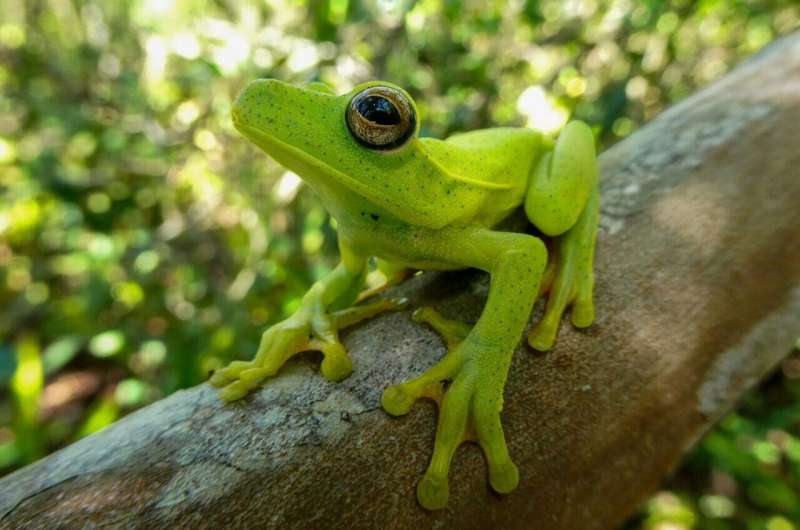This article has been reviewed according to Science X's editorial process and policies. Editors have highlighted the following attributes while ensuring the content's credibility:
fact-checked
peer-reviewed publication
trusted source
proofread
Unexpected diversity of light-sensing proteins goes beyond vision in frogs

Frogs have maintained a surprising diversity of light-sensing proteins over evolutionary time, according to a new study led by a Penn State researcher. Light-sensing proteins, called opsins, enable vision in sighted animals, and are responsible for many more biological functions including regulating circadian rhythms.
The researchers explored the evolution of nonvisual opsins in frogs, finding that most modern species examined in this study retained a shocking number of these proteins. The findings were published in the June issue of the journal Molecular Biology and Evolution.
"When we think about sensory biology, vision tends to dominate our understanding of light perception," said Jack Boyette, doctoral student in the Department of Biology at Penn State and lead author on the paper.
"But nonvisual light sensitivity has myriad other biologically critical functions, like calibration of circadian rhythm, melatonin release, pupil response, and detection and response to seasonal changes. These functions are all initiated by nonvisual opsins."
Nonvisual opsins are ubiquitous throughout the animal kingdom and are expressed in multiple tissues within and outside of the eye. Despite their broad importance, the researchers said these nonvisual opsins are relatively understudied. Frogs, the researchers said, provide an opportunity to study the proteins under diverse ecological conditions.
"Frogs are cool because different species can live in the water, on land, in trees or even underground," Boyette said. "This gets further complicated by things like activity period—a lot of frog species are active at night, but some are active during the daytime. As you can imagine, all these different habitats have very distinct light environments, which has implications for the evolution and the function of sensory systems."
To investigate the evolution of opsin diversity in frogs, the researchers combined genetic data from transcriptomes—the genetic sequences of all genes expressed in an organ—from the eyes of 81 frog species with publicly available genomes and multi-tissue transcriptome data from 21 additional species. These 102 species provided a broad sampling of frogs with different ecological adaptations.
"Whereas the common ancestor of tetrapods—four legged creatures that include mammals, amphibians and reptiles—likely had 18 opsin genes, several groups including mammals and snakes have lost many opsin genes through the course of evolution," Boyette said.
"Researchers have hypothesized that these groups underwent a nocturnal bottleneck over the course of their evolution, where they transitioned to nocturnal lifestyles and essentially lost the need for broad spectral sensitivity, which nonvisual opsins confer."
Frogs are also an ancestrally nocturnal group, so the researchers expected to find reduced nonvisual opsin diversity in frogs. Remarkably, the frog genomes assessed in this study contained all 18 ancestral vertebrate nonvisual opsins and 4 of 5 ancestral visual opsins. This surprising finding may result from complex life histories, according to Boyette.
"Within the lifetime of a single animal, many frog species transition between drastically different light environments," Boyette said. "Even though a lot of adult frogs are nocturnal, that's not necessarily true of the larval tadpoles.
"And so, we can get adaptive decoupling between life stages, where adults may not be dependent on the broad spectral sensitivity conferred by a bunch of nonvisual opsins, but the larvae could be dependent on them. Meaning that for these frogs to survive, they need to maintain this nonvisual opsin diversity."
Out of the 18 nonvisual opsins identified in the genomes, the researchers found 14 that were consistently expressed in frog eyes. In a subset of nonvisual opsins, they also found evidence of a type of natural selection called positive selection, in which new advantageous genetic variants are favored. The strongest signature of selection was in a gene called pinopsin, an opsin thought to be important for low-light photoreception in several types of animals.
Additionally, the researchers identified genetic differences in opsins between groups with differing ecologies and life histories. This could potentially indicate that frog nonvisual opsins have adapted to specific lifestyles or environments, Boyette said.
Boyette said he hopes that this research will inform future studies that test the explicit functions of nonvisual opsin genes in experimental settings.
"Although nonvisual opsins are found in a wide variety of animals, including humans, they are poorly understood," Boyette said. "This study fills an important gap in our understanding of how opsins have evolved in vertebrates."
More information: John L Boyette et al, Diversity and Molecular Evolution of Nonvisual Opsin Genes across Environmental, Developmental, and Morphological Adaptations in Frogs, Molecular Biology and Evolution (2024). DOI: 10.1093/molbev/msae090
Journal information: Molecular Biology and Evolution
Provided by Pennsylvania State University



















